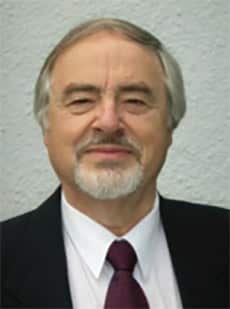Biography
Wolfgang J. R. Hoefer (M’71–SM’78–F’91-LF’07) obtained his Diplom-Ingenieur (Dipl.-Ing.) degree from the Technical University (Rheinisch-Westfälische Technische Hochschule – RWTH) Aachen in Germany in 1965, and his Docteur-Ingénieur (D. Ing.) degree from the University of Grenoble in France in 1968. In 2007, he received an honorary Doktor-Ingenieur (Dr.-Ing. h.c.) degree from the Technical University of Munich in Germany.
He began his career as a post-doctoral researcher and lecturer at the Institut Universitaire de Technologie (IUT) in Grenoble. In 1969, he joined the University of Ottawa as a faculty member and served as the Chair of Electrical Engineering for three years. In 1992, he became a Professor and NSERC Industrial Research Chair at the University of Victoria in British Columbia, where he founded and led the Computational Electromagnetics Research Laboratory (CERL) until his retirement in 2006. After his retirement, he spent three years at the A*Star Institute of High Performance Computing in Singapore as a Principal Scientist and founded and led the IHPC Independent Investigatorship Department. He is now a Professor Emeritus at the University of Victoria. Throughout his career he has held visiting appointments at various universities and institutions around the world, including the Universities of Grenoble, Rome Tor Vergata, Nice-Sophia Antipolis, Perugia, Munich, and Duisburg, as well as the Ferdinand Braun Institut Berlin, ETH Zürich, AEG-Telefunken, CRC Ottawa, the Institute of High Performance Computing, Singapore, and the Georgia Institute of Technology, Atlanta, GA, USA. In addition to his academic pursuits, Hoefer founded Faustus Scientific Corporation, where he has served as President and CEO for 21 years.
He is a Life Fellow of the Institute of Electrical and Electronics Engineers (IEEE), a Fellow of the Royal Society of Canada (RSC), the German Academy of Science and Engineering (ACATECH), the Canadian Academy of Engineering (CAE), the Engineering Institute of Canada (EIC), the Applied Computational Electromagnetics Society (ACES), and the Electromagnetics Academy at MIT (EMA). Throughout his career, he has held various leadership positions, serving as the co-founder and Managing Editor of the International Journal of Numerical Modelling (J. Wiley & Sons), as Associate Editor of the IEEE Transactions on Microwave Theory and Techniques, Chair and Co-Chair of the IEEE MTT-15 Technical Committee on Field Theory (Now TC-1), and as a Distinguished Microwave Lecturer of the IEEE Microwave Theory and Techniques Society (IEEE MTT-S). He has received numerous awards, including the IEEE MTT-S Microwave Career Award, the IEEE MTT-S Microwave Pioneer Award, the IEEE MTT-S Distinguished Educator Award, the IEEE Canada McNaughton Award & Gold Medal, the Most Inspiring Mentor Award from A*Star Singapore, the ACES Mainstay Award, and the Peter Johns Prize.
Presentations
Multi-Level Modeling for Complex Microwave/High-Speed Design
Complex communication and information systems operating in the Gigahertz range often combine multiple analog and digital functions. The design of such systems must capture all electromagnetic effects and interactions that impact their performance. However, it is impossible to model such systems globally at the field and device levels. Therefore, designers must take a hierarchical approach (top-down design) by which the system is conceived at a high level of abstraction and in behavioral terms. The specifications for its functional components are formulated at the network or circuit level. They, in turn, define a physical structure that requires frequency- or time-domain electromagnetic field analysis. Once the functional components have been realized, their actual physical behavior must be analyzed or measured, including possible parasitic
interactions between them, and abstracted into realistic (as opposed to initially specified) behavioral models that accurately predict their impact on overall system performance (bottom-up verification). This methodology also addresses signal integrity, packaging, interconnects, electromagnetic compatibility (EMC), and thermal issues.
The purpose of this lecture is to familiarize our members with evolving design approaches for systems of large technological and functional complexity, and to demonstrate how microwave modeling and design practices can be integrated into a wider flexible multi-level modeling environment. Techniques for interfacing models at the behavioral, network, circuit and field levels will be demonstrated. They range from order reduction of field models to the coupling of field- and circuit solvers, extraction of equivalent circuits from field solutions and measurements, behavioral representation by neural networks, and the linking of electromagnetic and thermal solvers. The key is to describe different parts of a complex structure by the most appropriate model of lowest possible order, while maintaining a two-way correspondence between functional behavior and physics across the modeling hierarchy.
